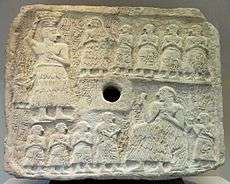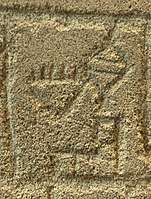Ur-Nanshe
Ur-Nanshe (Sumerian: 𒌨𒀭𒀏, UR-NANŠE) also Ur-Nina, was the first king of the First Dynasty of Lagash (approx. 2500 BCE) in the Sumerian Early Dynastic Period III. He is known through inscriptions to have commissioned many buildings projects, including canals and temples, in the state of Lagash,[4] and defending Lagash from its rival state Umma.[5] He was probably not from royal lineage, being the son of Gunidu (𒄖𒉌𒁺) who was recorded without an accompanying royal title.[5][6] He was the father of Akurgal, who succeeded him, and grandfather of Eanatum.[6] Eanatum expanded the kingdom of Lagash by defeating Umma as illustrated in the Stele of the Vultures and continue building and renovation of Ur-Nanshe's original buildings.[7]
| Ur-Nanshe 𒌨𒀭𒀏 | |
|---|---|
| King of Lagash | |
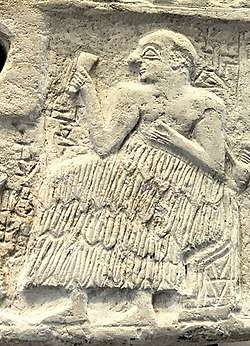 Ur-Nanshe, seated, wearing flounced skirt. The text to the right of his head reads "Ur-Nanshe" (𒌨𒀭𒀏, UR-NANŠE). The text in front of him reads "Boats from the land of Dilmun carried the wood" (𒈣 | |
| Reign | c. 2550 BC – 2500 BC |
| Predecessor | Lugal-sha-engur |
| Successor | Akurgal |
| Dynasty | 1st Dynasty of Lagash |
| Father | Gunidu |
He ascended after Lugalshaengur (lugal-ša-engur), who was the ensi, or high priest of Lagash, and is only known from the macehead inscription of Mesilim.[8]
Temples
According to the Perforated Relief of King Ur-Nanshe, temples attributed to Ur-Nanshe include Ningirsu's temple in Girsu, Nanshe's temple in Nina, and Apsubanda.[4] He is known to have originally built the Ibgal of Inanna, because of Eanatum's honorary inscriptions left after temple renovation.[7] The Ibgal of Inanna is located in modern-day al-Hiba (ancient city of Lagash). An oval wall surrounds the main mud brick temple and it is located on the southwest edge of the city. This placement within the city is different because temples were usually centrally positioned in ancient Sumer.[7]
Inscriptions
Ur-Nanshe has left behind many inscriptions and plates that depict him, his family, and court.[5]
The Perforated Relief
The Perforated Relief of King Ur-Nanshe is on display at the Louvre. The king is portrayed as a builder of temples and canals, thus a preserver of order perceived to be bestowed upon them by the gods.[4] It is a perforated limestone slab that was probably part of a wall as a votive decoration and is inscribed in Sumerian:
𒌨𒀭𒀏 / 𒈗 / 𒉢𒁓𒆷 / 𒌉𒄖𒉌𒁺 / 𒌉𒄥𒊬 / 𒂍𒀭𒊩𒌆𒄈𒋢 𒈬𒆕 / 𒍪𒀊𒌉𒁕 𒈬𒆕 / 𒂍𒀭𒀏 𒈬𒆕
Ur-Nanshe / lugal / Lagash / dumu Gunidu / dumu Gurmu/ e2 Ningirsu mu-du3 / abzu-banda3da mu-du3 / e2 Dnanshe mu-du3
“Ur-Nanshe, king of Lagash, son of Gunidu, son of Gurmu, built the temple of Ningirsu, built Apsubanda, built the temple of Nanshe.”
The carved illustration is in two registers, top and bottom, both depicting Ur-Nanshe in different roles as king. In the top register he is dressed in a kaunakes (tufted wool skirt), carrying a basket of bricks on his head while surrounded by other Lagash elite, his wife, and seven of his sons.[9] Inscriptions on their respective garments identify each person. On the bottom register, Ur-Nanshe is at a banquet, which is to celebrate the building of the temple. He is seated on a throne wearing the same outfit as the top register surrounded by other court members. In both registers Ur-Nanshe is shown using hierarchical proportion in which he is considerably larger than everyone surrounding him.[4]
A part of the inscriptions, in front of the seated king, reads: “Boats from the (distant) land of Dilmun carried the wood (for him)”.[4] This is the oldest known written record of Dilmun and importation of goods into Mesopotamia.[5]
.jpg) The relief at time of discovery
The relief at time of discovery Ur-Nanshe on the relief. He is also depicted wearing a basket for the construction of a temple.
Ur-Nanshe on the relief. He is also depicted wearing a basket for the construction of a temple.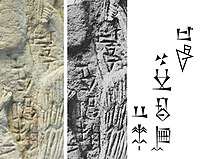
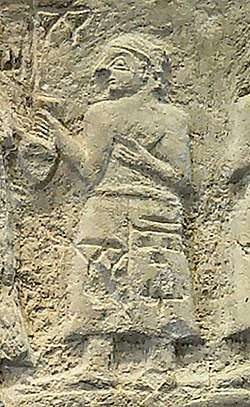 Ur-Nanshe's son Akurgal (𒀀𒆳𒃲) on the relief.
Ur-Nanshe's son Akurgal (𒀀𒆳𒃲) on the relief.
Door socket

An inscribed door socket from Ur-Nanshe is also known, now in the Louvre Museum. The full inscription of the door socket has been translated as:
"Ur-Nanshe, the king of Lagash, the son of Gunidu, the son of Gurmu, built the house of Ningirsu; built the house of Nanshe; built the house of Gatumdug; built the harem; built the house of Ninmar. The ships of Dilmun brought him wood as a tribute from foreign lands. He built the Ibgal; built the Kinir; built the scepter (?)-house."
 The door socket of Ur-Nanshe at time of discovery.
The door socket of Ur-Nanshe at time of discovery.
The Plaque of Ur Nanshe
The Plaque of Ur Nanshe is a limestone plaque currently located at the Louvre Museum that honors Ur Nanshe. The figures displayed are the king and his court standing rigid and wide eyed, paying homage to the god Nanshe. They are dressed in kaunakes with their hands clasped together over their chest. Hierarchical scale of the king and the use of cuneiform on the figures to identify them[21] are employed as in the Perforated Relief.
𒌨𒀭𒀏 / 𒈗 / 𒉢𒁓𒆷 / 𒌉𒄖𒉌𒁺 / 𒂍𒀭𒊩𒌆𒄈𒋢 / 𒈬𒆕
Ur-Nanshe / lugal / Lagash / dumu Gunidu / E-Ningirsu / mudu
"Ur-Nanshe, king of Lagash, son of Gunidu, built the temple of Ningirsu"
 Plaque of Ur-Nanshe at time of discovery
Plaque of Ur-Nanshe at time of discovery Ur-Nanshe himself
Ur-Nanshe himself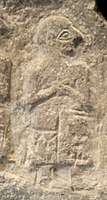 Akurgal (𒀀𒆳𒃲) as a child in the limestone votive relief of Ur-Nanshe
Akurgal (𒀀𒆳𒃲) as a child in the limestone votive relief of Ur-Nanshe
Additional inscriptions
There are many other inscriptions found by or mentioning Ur-Nanshe. Some of them include a listing of rulers of Lagash and a Hymn to Nashe.[5]
Excerpt from Ruler of Lagash:
“Ur-Nanše, the son of ……, who built the E-Sirara, her temple of happiness and Niĝin, her beloved city, acted for 1080 years. Ane-tum, the son of Ur-Nanše”[24]
Excerpt from A Hymn to Nashe:
“There is perfection in the presence of the lady. Lagaš thrives in abundance in the presence of Nanše. She chose the šennu in her holy heart and seated Ur-Nanše, the beloved lord of Lagaš, on the throne. She gave the lofty scepter to the shepherd.”[25]
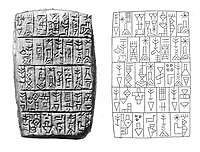

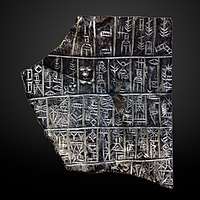
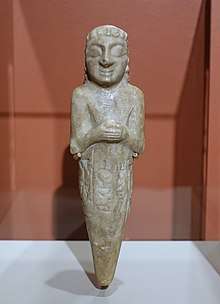 Goddess Shul-utul, foundation peg, with inscription "Ur-Nanshe, King of Lagash, son of Gunidu, built the shrine Girsu", probably Girsu, Tell Telloh, Iraq, mid 3rd millennium BCE. Harvard Semitic Museum, Cambridge, MA
Goddess Shul-utul, foundation peg, with inscription "Ur-Nanshe, King of Lagash, son of Gunidu, built the shrine Girsu", probably Girsu, Tell Telloh, Iraq, mid 3rd millennium BCE. Harvard Semitic Museum, Cambridge, MA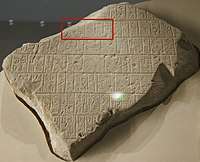
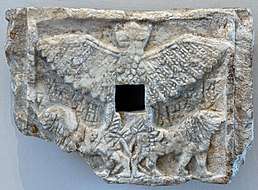 Votive relief of Ur-Nanshe, king of Lagash, representing the bird-god Anzû (or Im-dugud) as a lion-headed eagle. Alabaster, Early Dynastic III (2550–2500 BC). Found in Telloh, ancient city of Girsu.
Votive relief of Ur-Nanshe, king of Lagash, representing the bird-god Anzû (or Im-dugud) as a lion-headed eagle. Alabaster, Early Dynastic III (2550–2500 BC). Found in Telloh, ancient city of Girsu.
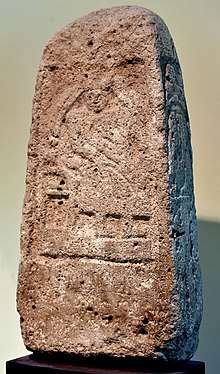 Stele of Ur-Nanshe with goddess Nisaba, ruler of Lagash, from Lagash, Iraq, 26th century BCE. Iraq Museum
Stele of Ur-Nanshe with goddess Nisaba, ruler of Lagash, from Lagash, Iraq, 26th century BCE. Iraq Museum
See also
| Wikimedia Commons has media related to Ur-Nanshe. |
References
- Lourve Pouysségur, Patrick , ed. "Perforated Relief of King Ur-Nanshe." Louvre Museum. Louvre Museum. Web. 13 Mar 2013..
- Transliteration: "CDLI-Found Texts". cdli.ucla.edu.
- Similar text: "CDLI-Found Texts". cdli.ucla.edu.
- Lourve Pouysségur, Patrick , ed. "Perforated Relief of King Ur-Nanshe." Lourve Museum. Louvre Museum. Web. 13 Mar 2013..
- CDLI Wiki University of Oxford, 14 Jan 2010. Web. 13 Mar 2013.
- Van De Mieroop, Marc (2004). A History of the Ancient Near East: Ca. 3000-323 BC. Wiley. pp. 50–51. ISBN 9780631225522.
- Hansen, Donald "Royal Building Activity at Sumerian Lagash in the Early Dynastic Period." Biblical Archaeologist. 55.4 (1992): 206-11. Print.
- "CDLI-Found Texts". cdli.ucla.edu.
- Finegan, Jack (2019). Archaeological History Of The Ancient Middle East. Routledge. p. 44. ISBN 978-0-429-72638-5.
- Thomas, Ariane; Potts, Timothy (2020). Mesopotamia: Civilization Begins. Getty Publications. p. 164. ISBN 978-1-60606-649-2.
- "CDLI-Found Texts". cdli.ucla.edu.
- "CDLI-Found Texts". cdli.ucla.edu.
- "CDLI-Found Texts". cdli.ucla.edu.
- Kramer, Samuel Noah (2010). The Sumerians: Their History, Culture, and Character. University of Chicago Press. p. 308, Door socket. ISBN 978-0-226-45232-6.
- Kramer, Samuel Noah (2010). The Sumerians: Their History, Culture, and Character. University of Chicago Press. p. 308 #6. ISBN 978-0-226-45232-6.
- Full transcription: "CDLI-Found Texts". cdli.ucla.edu.
- Full transcription: "CDLI-Found Texts". cdli.ucla.edu.
- Kramer, Samuel Noah (2010). The Sumerians: Their History, Culture, and Character. University of Chicago Press. p. 308 #6. ISBN 978-0-226-45232-6.
- Thomas, Ariane; Potts, Timothy (2020). Mesopotamia: Civilization Begins. Getty Publications. p. 164. ISBN 978-1-60606-649-2.
- Art of the First Cities: The Third Millennium B.C. from the Mediterranean to the Indus. Metropolitan Museum of Art. 2003. p. 71. ISBN 978-1-58839-043-1.
- Cole, Karl. "Plaque of Ur Nanshe." SchoolArts. 100.1 (2000): 33. Print.
- Thomas, Ariane; Potts, Timothy (2020). Mesopotamia: Civilization Begins. Getty Publications. p. 164. ISBN 978-1-60606-649-2.
- Art of the First Cities: The Third Millennium B.C. from the Mediterranean to the Indus. Metropolitan Museum of Art. 2003. p. 71. ISBN 978-1-58839-043-1.
- E, J. translation : t.2.1.2." rulers of Lagaš (2003): n.pag. Electronic Text Corpus of Sumerian Literature. Web. 13 Mar 2013.
- C, G. Translation: t.4.14.1." hymn to Nanše (Nanše A) (2003): n.pag. Electronic Text Corpus of Sumerian Literature. Web. 13 Mar 2013.
- Kramer, Samuel Noah (2010). The Sumerians: Their History, Culture, and Character. University of Chicago Press. p. 308. ISBN 978-0-226-45232-6.
- de Sarzec, E. (1892). "Deux Tablettes Archaïques de Tello". Revue d'Assyriologie et d'archéologie orientale. 2 (4): 146–149. ISSN 0373-6032. JSTOR 23284262.
- Full transliteration: "CDLI-Found Texts". cdli.ucla.edu.
- Kramer, Noah (1964). "The Indus civilization and Dilmun" (PDF). Expeditions WWW.penn.museum: 49.
- Kramer, Samuel Noah (2010). The Sumerians: Their History, Culture, and Character. University of Chicago Press. p. 308. ISBN 978-0-226-45232-6.
- de Sarzec, E. (1892). "Deux Tablettes Archaïques de Tello". Revue d'Assyriologie et d'archéologie orientale. 2 (4): 146–149. ISSN 0373-6032. JSTOR 23284262.
- Full transliteration: "CDLI-Found Texts". cdli.ucla.edu.
- "Louvre Museum Official Website". cartelen.louvre.fr.
- Full transcription: "CDLI-Archival View". cdli.ucla.edu.
- Sallaberger, Walther; Schrakamp, Ingo (2015). History & Philology (PDF). Walther Sallaberger & Ingo Schrakamp (eds), Brepols. pp. 74–76. ISBN 978-2-503-53494-7.
- Découvertes en Chaldée... / publiées par L. Heuzey . 1ère-4ème livraisons / Ernest de Sarzec - Choquin de Sarzec, Ernest (1832-1901). pp. Plate XL.
- "plaque / figurine". British Museum.
- "CDLI-Archival View". cdli.ucla.edu.
| Regnal titles | ||
|---|---|---|
| Preceded by Lugalshaengur |
King of Lagash ca. 25th century BCE |
Succeeded by Akurgal |
